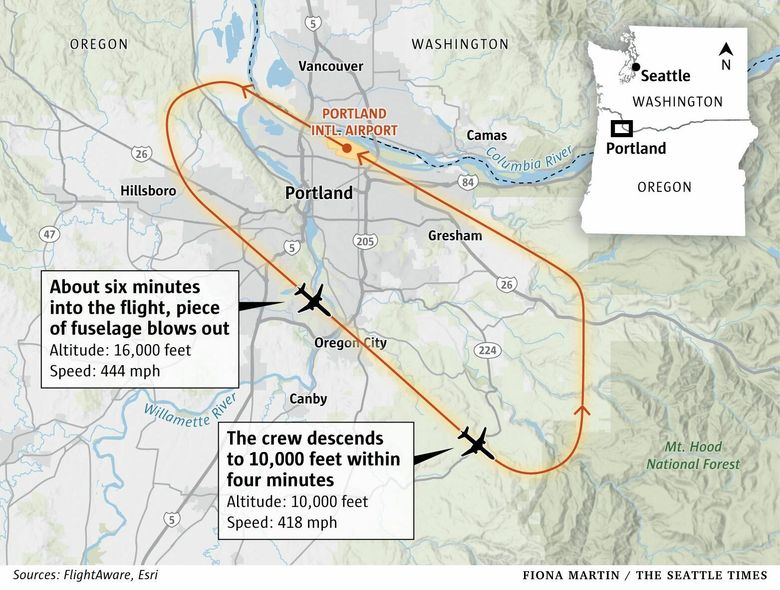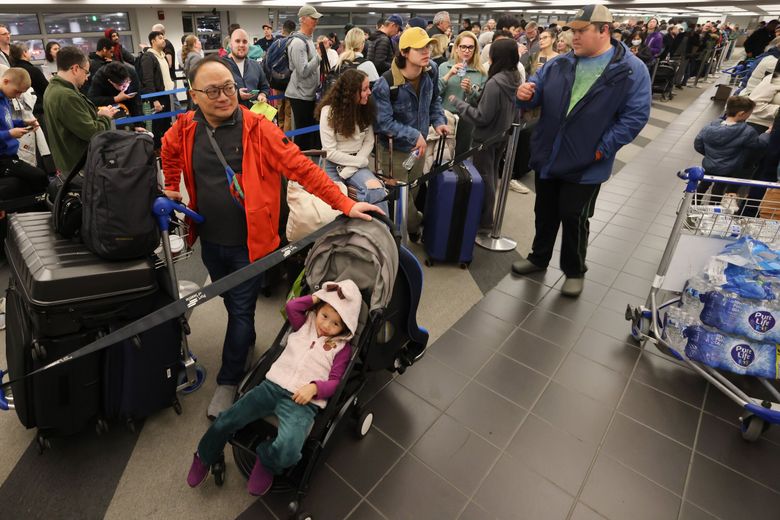The fuselage blowout on Alaska Airlines’ Boeing 737 MAX 9: What we know
Jan. 6, 2024 at 12:34 pm Updated Jan. 6, 2024 at 3:03 pm


1 of 4 | Alaska Airlines N704AL, a 737 MAX 9 which made an emergency landing at Portland International Airport after a part of the fuselage broke off mid-flight on Friday, is parked at a maintenance hanger in Portland, Ore., Saturday. (Craig Mitchelldyer / The Associated Press)
By
Taylor Blatchford
and
Dominic Gates
Seattle Times staff reporters
The Boeing 737 MAX 9 has been temporarily grounded by the Federal Aviation Administration following an in-flight blowout at 16,000 feet that forced an Alaska Airlines flight to make an emergency landing in Portland on Friday evening.
Saturday’s grounding led to more than 100 flight cancellations around the country. Most MAX 9 aircraft will have the part that fell off the plane on Friday inspected, a process that will take four to eight hours, before it can return to the skies.

This photo provided by an unnamed source shows the damaged part of an Alaska Airlines Boeing 737 MAX 9, Flight 1282, which was forced to return to Portland International Airport on Friday. (The Oregonian via AP)
Federal investigators have just begun their work, but early reports on the Alaska Airlines flight indicate a panel that plugs an unused door hole on the fuselage blew out of the plane. The flight had not reached cruising altitude, and, while several passengers were injured, all have since been cleared medically, according to the airline.
Here’s what we know about the incident and its impacts.
Related Alaska Airlines grounds Boeing MAX 9 fleet: What we know Emergency at 16,000 feet
The Alaska Airlines plane departed from Portland and had risen to 16,000 feet when a large rectangular hole opened next to an empty seat. The plane, which had been headed to Ontario, Calif., made an emergency landing at Portland International Airport 20 minutes after taking off.
Alaska Airlines Flight 1282 path
An Alaska Airlines 737 MAX 9 bound for Ontario, Calif., made an emergency landing Friday shortly after taking off from Portland International Airport.

It appears a piece of fuselage blew out and passengers saw a gaping hole, felt a rush of air leaving the cabin and saw oxygen masks drop from the ceiling.
Inside the 737 MAX 9
The rectangular hole in the fuselage of Alaska Airlines Flight 1282 appeared where Boeing fits a plug to seal a door opening that is not used by most airlines.

“It was deathly silent” aboard the plane, said 29-year-old passenger Kyle Rinker in a text message to The Oregonian/OregonLive. “Nobody made a noise. You could feel the plane shake a little because of the air pressure difference.”
About the incident
Investigators with the FAA and National Transportation Safety Board had just begun their work Saturday. Initial reports indicate all 171 passengers and six crew aboard the flight were safe, with some injuries requiring medical care, Alaska said. Fortunately, no passenger was seated by the opening.
The rectangular hole that appeared in the fuselage was located where Boeing fits a plug to seal a door opening that is not used as a door by most airlines, and by no U.S. carriers.
An emergency exit door is installed in that location only for jets going to low-cost carriers like Ryanair, which cram in additional seats that require an extra emergency exit. Otherwise, the hole is sealed with a plug, and from the inside it is covered by a sidewall. To a passenger, it looks like a normal window, not a door opening.
This plug, halfway between the over-wing emergency exit door and the door at the rear of the plane, is present only on the largest versions of the 737 MAX.
There is no immediate explanation as to why the plug blew out. Photos and videos from passengers inside the jet show clean metal brackets where the plug would be latched, with no visible breaks, deformations or tears in the metal.
The entire 737 fuselage, including the door plug, is assembled in Wichita, Kan., by Boeing’s major supplier, Spirit AeroSystems.

Kelvin Lau, left, waits with his family, including daughter Chloe Lau, 3, in stroller, to rebook a cancelled Alaska Airlines flight at Seattle-Tacoma International Airport Saturday. (Karen Ducey / The Seattle Times)
About cancellations
The number of cancellations will depend on how long it takes the FAA to clear the 737 MAX 9 for flight, but hundreds of cancellations are expected. Alaska expects service to be impacted into the middle of the week.
Alaska Airlines canceled more than 160 flights around the country on Saturday after announcing it would be voluntarily grounding its fleet of MAX 9s.
The canceled flights represent 15% of Alaska’s scheduled flights, according to flight tracking website FlightAware. More than 100 additional Alaska flights were delayed as of midday Saturday.
Before the FAA-mandated grounding, United Airlines also temporarily pulled some MAX 9s from service to conduct emergency inspections, according to a Bloomberg report. The airline has 78 MAX 9s in operation.
Other airlines also canceled flights Saturday. Travelers facing a cancellation can look to these tips.
About the grounding
The FAA on Saturday ordered the temporary grounding of most MAX 9 aircraft operated by U.S. airlines or in U.S. territory. Other aviation authorities around the globe are likely to follow the FAA’s lead.
“The FAA is requiring immediate inspections of certain Boeing 737 MAX 9 planes before they can return to flight,” said FAA administrator Mike Whitaker. “Safety will continue to drive our decision-making as we assist the NTSB’s investigation into Alaska Airlines Flight 1282.”
Most Read Business Stories The Emergency Airworthiness Directive, or EAD, will require operators to inspect before further flight aircraft that do not meet the inspection cycles specified in the EAD.

In this March 2020 photo, a Boeing 737 MAX 9, built for Alaska Airlines, undergoes testing as it flies past the Boeing factory in Everett. Visible... (Mike Siegel / The Seattle Times, 2020)
All MAX 9s remain grounded.
Alaska said the inspections would be “completed in the next few days.” The required inspections will take around four to eight hours per aircraft.
About the 737 MAX 9
737 Mid-Cabin Emergency Exit Doors

The Boeing 737 Technical Channel
23.4K subscribers
Jan 6, 2024
This video is in response to the incident to Alaskan Airlines flight AS 1282 whose mid-cabin emergency exit door detached in-flight whilst climbing through 16,000ft on 5 Jan 2024. Fortunately, there were no injuries. In it I cover the reason for the mid-cabin exit door, its construction and operation, Door Warnings & Flightlocks, the SPSEU, MAX PSEU Differences and Alaskan 1282.
youtube.com
The MAX 9 is the largest plane in Boeing’s MAX series currently flying. The company has delivered a total of 218 MAX 9s worldwide.
The plug at issue in the incident is fitted on the previous generation 737-900ER and the same design is on the 737 MAX 8-200, the high-density version of the jet for low-cost carriers, as well as the MAX 9 and MAX 10, which has not yet been certified to carry passengers.
It is not present on the MAX 7 or MAX 8.
Online FAA records show the MAX 9 involved in Friday’s incident was almost new. Boeing delivered the jet to Alaska on Oct. 31.
FlightAware data shows Flight 1282 was the aircraft’s third flight of the day. It had flown from San Diego to New York overnight and then on to Portland earlier in the day.
The troubled history of the 737 MAX
The 737 MAX is the latest version of Boeing’s signature narrowbody jetliner. Alaska had recently transitioned to an all-Boeing fleet and relies heavily on the MAX, which has been in service since 2017 and has accumulated over 6.5 million flight hours globally. (The airline’s $1.9 billion proposed purchase late last year of Hawaiian Airlines would add Airbus planes to its roster.)
MAX crashes in 2018 and 2019 saw all versions of the plane grounded. The investigation that followed showed that a flawed flight control system in the plane was the primary cause of both tragedies.
In late December, Boeing informed airlines and the FAA of a possible loose bolt in the rudder control system of Boeing 737 MAX airplanes and required inspections of specific tie rods that control rudder movement for possible loose hardware.
In 2018, a woman died after a damaged engine on a Southwest Airlines 737 hurled shrapnel at the fuselage and broke a cabin window beside the passenger.
Taylor Blatchford: 206-464-2280 or tblatchford@seattletimes.com; on Twitter: @blatchfordtr. Taylor Blatchford is the engagement reporter for The Seattle Times' investigative team.
Dominic Gates: 206-464-2963 or dgates@seattletimes.com; on Twitter: @dominicgates.
seattletimes.com |




